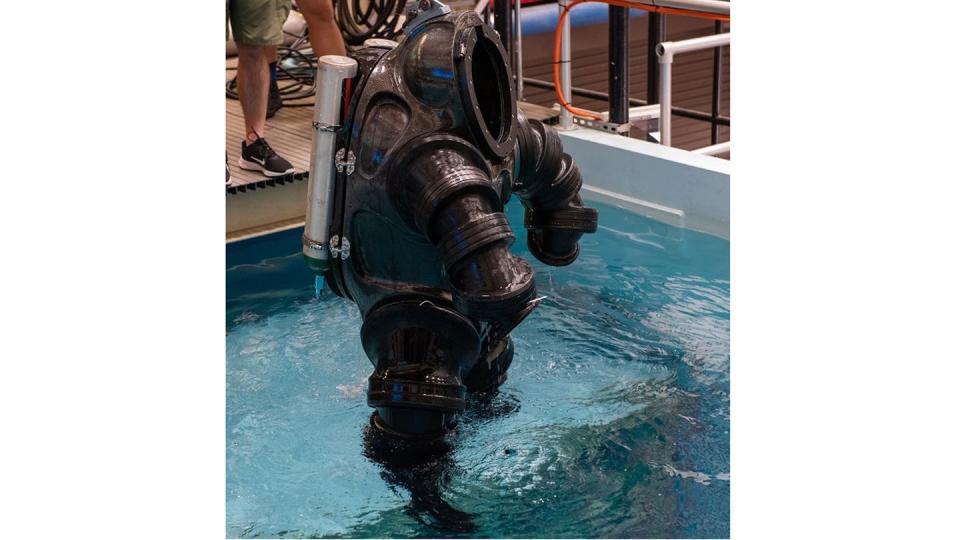The Navy is working on a transformational ‘Iron Man’ dive suit
The Navy is developing a new “Iron Man” diving suit that aims to enhance diver safety and allow them to work longer and in deeper waters.
The Deep Sea Expeditionary with No Decompression system, or DSEND as it is called, is a form-fitting atmospheric dive suit composed of rotating and flexible joints to provide divers with greater mobility while also keeping internal pressure steady.
“It is a hard suit that the diver crawls into,” Paul McMurtrie, Naval Sea Systems Command diving systems program manager and a retired Navy master diver, told Navy Times. “A good depiction would be an Iron Man suit for a diver underwater.”
Navy divers are tasked with deep ocean salvage of vessels and aircraft, underwater rescues, explosive ordnance disposal, ship hull maintenance and recovery of sunken equipment.
But one of the key challenges these divers face is dealing with water pressure in deep waters and decompression sickness, which happens when nitrogen doesn’t have enough time to clear from a diver’s blood due to a quick decrease in water pressure.
How Navy divers are preparing for the Arctic battlefront
To complete 20 to 25 minutes of work deep underwater, a typical work session, divers now must use a saturation system, or diving bell, pressurized with gas to match the outside water pressure. The deeper they descend, the greater the danger from increasing water pressure. They then gradually ascend — stopping at intervals — to prevent nitrogen from forming bubbles in their blood or tissue resulting in decompression sickness, known as “the bends,” and other complications like inner ear injuries due to undersea exposure.
After surfacing, divers then must spend another 90 minutes in a decompression chamber, McMurtrie said. Even following these protocols doesn’t eliminate the risk of decompression sickness entirely.
But the DSEND system aims to rectify these issues.
The suit, which has been in the works for more than five years, eliminates the need for a gradual ascent to the surface because it provides one consistent atmospheric pressure. This allows divers to spend greater time underwater, according to McMurtrie.

“With the suit, we can drop the guy down to the bottom, and he can work for up to six hours, and then come right back up,” McMurtrie said. “He gets out of the suit. Next guy jumps in. Boom. He’s back down for another six hours.
“A job that would take mixed-gas divers two to three weeks to complete, the suit could knock it out in a day or two with a much smaller team, a smaller footprint and in the safety of not having to undergo decompression sickness,” McMurtrie said.
The US Navy is combining diver teams as it readies for future wars
Although the concept of an atmospheric dive suit isn’t new, the Navy currently doesn’t use any because it found they were too heavy and presented logistical challenges for the Navy, according to Dr. Sandra Chapman, a program officer in the Office of Naval Research’s warfighter performance department. Additionally, they were bulky and made it difficult for divers to maneuver and complete tasks.
The DSEND system ”is, in essence, a one-person submarine, but form-fitted to the point where the person can operate like a diver,” Chapman told Navy Times.
The Navy’s Office of Naval Research, Naval Sea Systems Command, Naval Undersea Warfare Center and Naval Surface Warfare Center Panama City are spearheading the project.
The DSEND suit is still in the early stages and won’t hit the fleet for at least several more years. At this point, it is still a concept in the early stages of product development as a technology candidate while initial prototypes are constructed.
Next steps for the suit include it being designted a future naval capability, sometime from fiscal 2025 to 2027, followed by a three-year development program to craft a prototype suit capable of diving 300 feet. If successful, the suit would then need certification prior to the production of multiple suits.
In demonstrations completed this year, the DSEND divers pulled a mannequin from an aircraft fuselage, salvaged wreckage and navigated tunnels similar to sunken vessels.
“These are all things that the current atmospheric dive suits could never do,” McMurtrie said. “So, what we’ve demonstrated in these demonstrations is that the suit can do just about anything a wet diver could do — could perform the same way.”
The demonstrations included both male and female divers, who were given several days to familiarize themselves with the suit, McMurtrie said. All the divers became very comfortable in the suit after such exposure.
“I think most Navy divers that get into the suit would probably be able to perform the same way,” he said.

